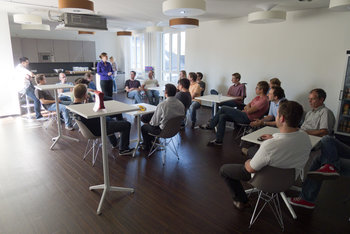

Goal Planning
The process of developing a strategy and mapping that to individual objectives.Strategic Drivers
Identification and analysis of the forces that shape strategy such as competition, customers, technology and regulations. For example, a team may conduct a SWOT analysis.Goals
Development of goals.Strategy
Development of strategies that achieve goals.Risk
An initial analysis of risk for use in prioritization.Prioritization
It is common to generate a large list of goals and related strategies that is prioritized such that only a small percentage are actively pursued in a given period. In other words, goals and strategies can be generated creatively but then a realistic process of prioritization refines the list down to the concrete goals that have the most value.Team Objectives
Breaking strategies down into objectives. These are typically designed to be specific, measurable, actionable, relevant and time-bound, commonly known as SMART.Individual Objectives
Individuals are assigned objectives based on team objectives. There is commonly room for individuals to add their own objectives and to break team objectives down into lower level milestones.Review & Approve
Individuals and managers review objectives and both sign off. The manager uses objectives to set expectations for performance. Objectives and related items such as deadlines may be negotiated by the employee. It is common to include a difficulty rating for each objective to document employee concerns that an objective is difficult to achieve.Performance Review
Objectives serve as an employee's goals for a year, half year or quarter. It is common for priorities to change and for objectives to be stale within weeks. Nevertheless, individual objectives are the basis for performance reviews.Feedback Gathering
An employee may gather feedback from stakeholders and peers to support their review. In many cases, this is a requirement.Self Assessment
The employee performs a self assessment based on the objectives and a rating scale. There are typically freeform text fields on the assessment that allow the employee to document accomplishments that may not be listed in the original objectives.Manager Assessment
The manager performs an assessment of the employee using the same form.Final Assessment
The employee and manager meet to compare assessments. Where there is a difference, the employee may pitch their case. The manager has the final call but the employee's self assessment is also documented.Communication of Assessment
The manager completes the final assessment based on the assessment meeting with the employee. This is communicated to the employee and to human resources.Performance Improvement
A low rating will typically trigger a human resources process. This can result in dismissal. The employee is typically given a chance to improve such that dismissal after one bad review is rare. However, this depends on the organization, labor laws and contracts that may apply.Compensation & Promotions
Performance reviews are typically the basis for salary adjustments, bonus assessments and promotion processes.| Overview: Goal Setting Process | ||
Type | ||
Definition | The process of documenting performance objectives for employees that serve as a basis for strategy implementation and performance review. | |
Related Concepts | ||































